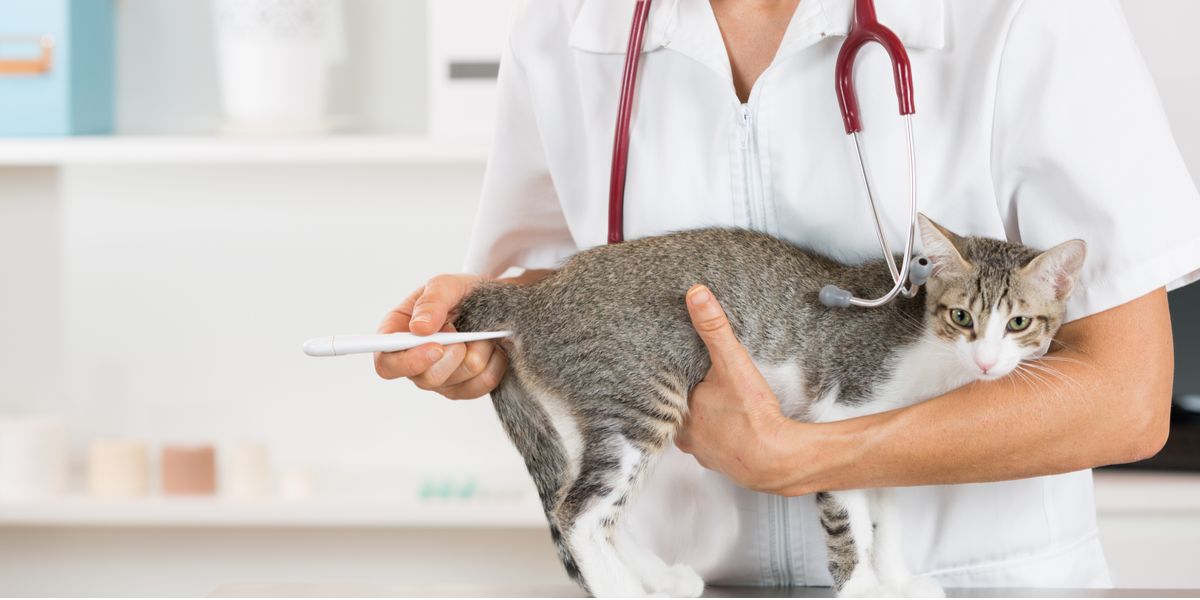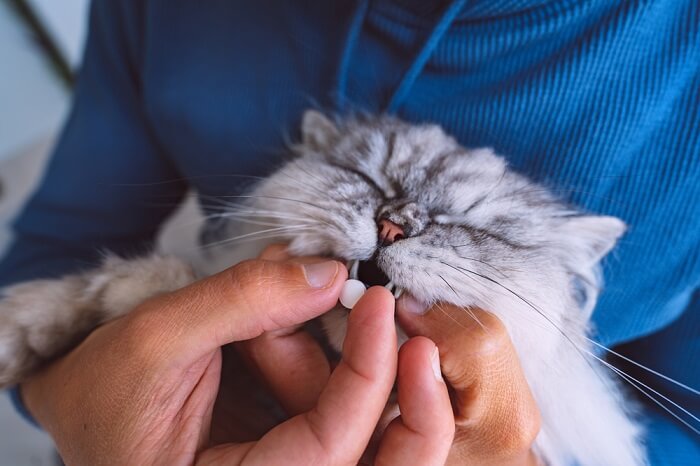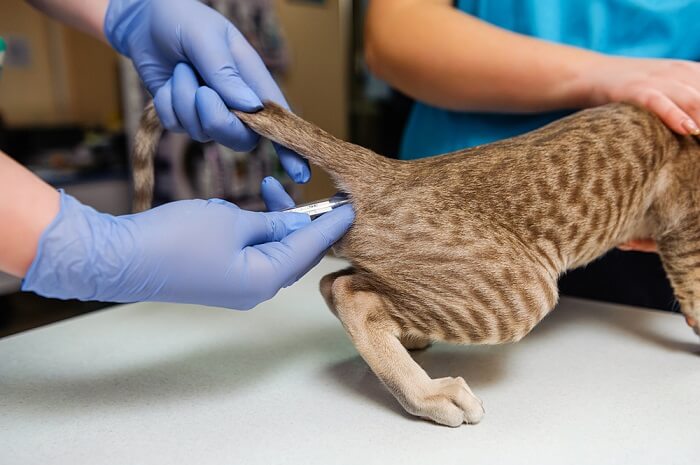
Fever in cats needs speedy veterinary care and lots of TLC from you. Keep reading to find out why fever happens, what you need to look out for (and avoid), and how best to help your cat recover.
When a cat’s immune system detects a threat, such as infection, inflammation, cancer, or certain medications, it releases chemicals that trigger a protective rise in body temperature, usually above 39.5°C (103.1°F).
This fever, as it is called, is designed to prevent the body from being overwhelmed by illness. A very high fever (such as over 41°C or 106°F) may damage internal organs and can be fatal, so it’s important to spot the signs of high fever and act early by contacting your vet.
How to Tell if a Cat Has a Fever?
Normally, feline internal body temperature should sit somewhere between 36.7°C to 39.2°C (98.1°F to 102.5°F). C
Signs your cat May have a fever:
- Lower energy and activity
- Lack of appetite
- Muscle shivering
- Breathing faster, panting
- Delirium, collapse or convulsions (seizures or fits) in severe cases
Common additional symptoms that are more specific to the various underlying causes of the fever include:
- “Pot-bellied,” swollen abdomen (e.g., wet form of feline infectious peritonitis or FIP)
- Limping (e.g., wounds or abscesses)
- Vomiting/diarrhea (e.g., gastroenteritis)
- Sneezing (e.g., cat flu)
- Weakness or pallor (e.g., feline infectious anemia)
Cats with any sort of pain or ill health adopt a Gloria Gaynor “I Will Survive” approach to life—they basically soldier on as normally as possible. It’s a feline instinctive way of avoiding bringing attention to themselves at this vulnerable time.
How To Take Your Cat’s Temperature
It is tricky to take a cat’s temperature with a rectal thermometer. If your cat is unwell enough for you to suspect fever, then they should be examined by your veterinarian.
If you’re booking a vet visit anyway, then it’s better for a trained professional to tackle this instead. Asking your vet to demonstrate how to take your cat’s temperature can be helpful for at-home monitoring.
Causes of Fever in Cats

If your cat’s fever is caused by a bacterial infection, your vet may prescribe antibiotics.
Fever is caused by many different things include viral and bacterial infections, and cancer and other diseases.
Viral infections
- Feline coronavirus: The most common cause of fever in cats has been reported as feline infectious peritonitis (FIP)
- Retroviruses: FeLV (feline leukemia virus) and FIV (feline immunodeficiency virus)
- Cat flu (feline herpes and caliciviruses)
- Feline panleukopenia virus (FPV, feline parvovirus, infectious enteritis)
- Rabies
Bacterial infections
- Abscesses and wounds
- Urinary and reproductive tract infections (e.g., bacterial cystitis, pyometra in unsterilized females)
- Septicemia (blood infection)
- Body cavity infections from migrated foreign objects (e.g., inhaled grass seeds, ingested bones), blunt trauma (e.g., ruptured intestines) or deep puncture wounds (e.g., attacks from predators)
- Food-borne bacteria (from contaminated food or prey)
- Ticks and Fleas infected with Mycoplasma, Bartonella, or Borrelia
Protozoan and Fungal Infections
- Cytauxzoon
- Toxoplasmosis
- Cryptococcosis
- Histoplasmosis
Inflammatory Diseases and Cancers of the Immune System
- Lymphoma
- Bone marrow cancer
Medications
- Tetracycline antibiotics
Diagnosis at the Vet
Getting your vet to examine your cat often reveals subtle signs that you have missed and helps narrow down what is causing the spike in body temperature and get the right treatment.
Clinical signs vets look for include:
- Pain
- Redness
- Swelling
- Fluid
- Scabs
- Open wounds
- Pusy discharge
- Jaundice (a yellow hue to the whites of their eyes and skin)
- Weight loss
Your vet may need a better internal picture of the cause of the fever so they’ll need to run diagnostic tests such as:
- General blood profiles: Blood patterns can indicate how long an illness has been there, how a cat’s body is coping and specific organ involvement (e.g., kidneys, liver, etc.).
- Infectious agent screening: Blood antibody/antigen levels and PCR tests help identify whether a viral, bacterial, or protozoal infection could be causing a persistent fever.
- Diagnostic Imaging: Radiography (x-rays), sonography (ultrasound) and MRI/CT scans can detect abnormal fluid deposits and structural changes in a cat’s bone anatomy and internal organs.
- Biopsies: Biopsying bone marrow and suspicious-looking tissues or fluids help identify cell patterns (cytology) and yield the infectious organism responsible (microbiology). Common samples tested include urine (urinalysis) and other bodily fluids that arise from beneath the skin, swollen joints, or body cavities like the abdomen and chest.
Treatment of Fever

Fever is caused by many different things include viral and bacterial infections, and cancer and other diseases.
Depending on their findings, your vet may suggest these common treatments:
Prescription Medications
- Cat-safe anti-inflammatories: These bring down high fevers, and relieve inflammation and pain while your vet is seeking a cause of the fever. Never give your cat human drugs like aspirin and acetaminophen (paracetamol) because these are toxic to cats.
- Antibacterial or antiviral medication
- Immunomodulating drugs and chemotherapy agents: these target inflammation and cancer.
- Nutraceuticals: These dietary supplements boost your cat’s own defenses.
Rehydration and Nutritional Therapy
Some dehydrated cats may need hospitalization and rehydrating with fluids via an intravenous drip or subcutaneously (under the skin). More severely affected cats may need tube feeding directly into their stomach.
At-Home Supportive Care
Regardless of the underlying condition, when thinking about a home remedy for cat with fever there is so much that you can do at home, alongside your vet’s treatments, to relieve fever symptoms and keep your cat hydrated and nourished so that they can fight the fever’s cause until the test results are available.
Here are some key things to focus on:
- Tempt sick or elderly cats to eat
- Encourage cats to improve their fluid intake
- Cool them down by gently wiping their armpits, groin, and temples (thinly haired area in front of the ears) with a lukewarm damp flannel or washcloth
- Offer options for cats to regulate their own comfort levels by allowing access to cooler parts of the house and garden and improving airflow with a safely opened window, air-conditioning or fans
When your cat’s temperature rises, both acknowledging there’s a problem and seeking veterinary attention swiftly can make a real difference to their comfort level and the speed of recovery. You can really be a vital support to your cat in their recovery by keeping them hydrated, nourished, and comfortable while any test results and treatments take effect.







